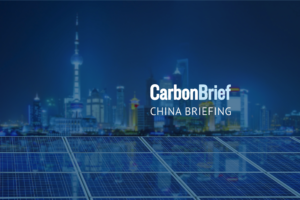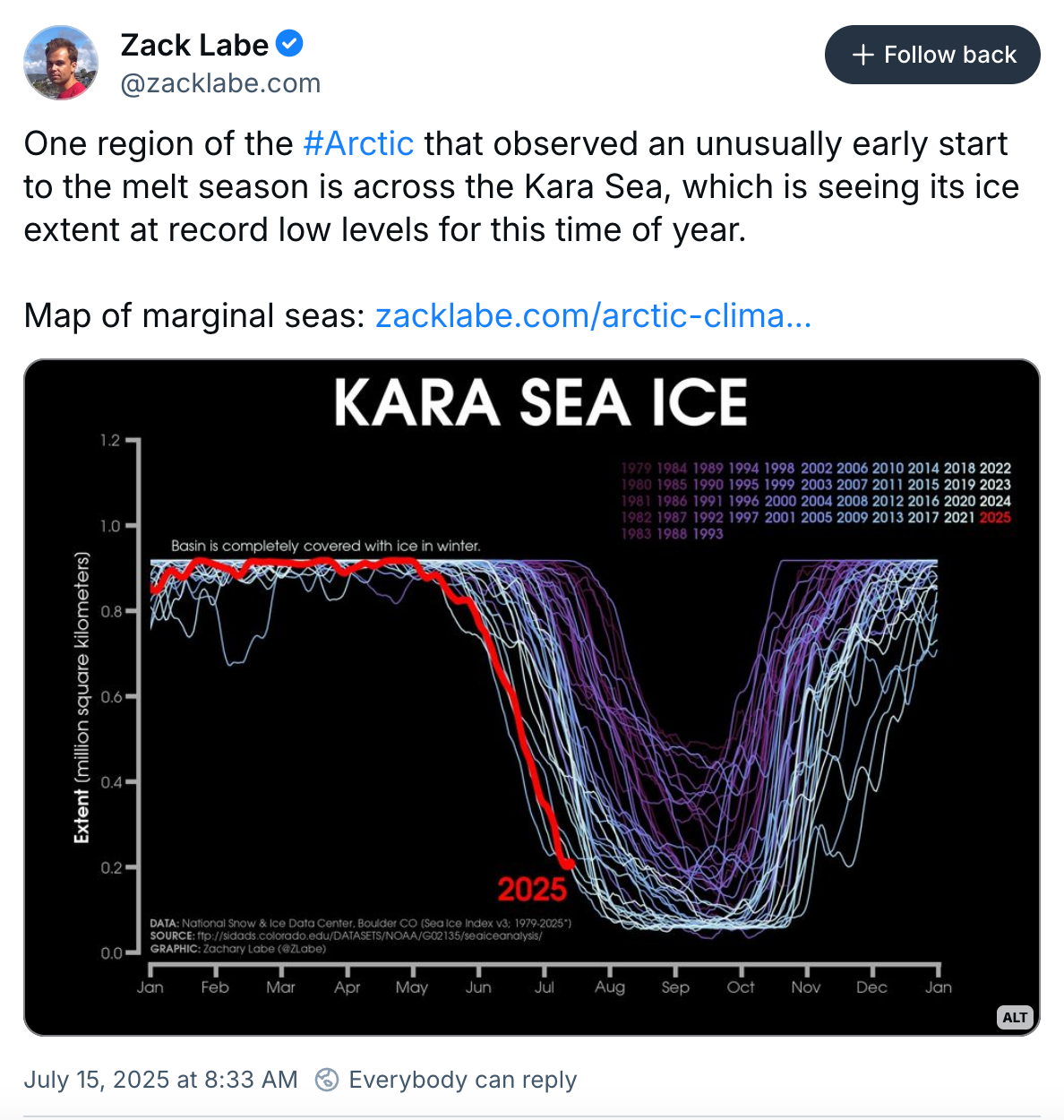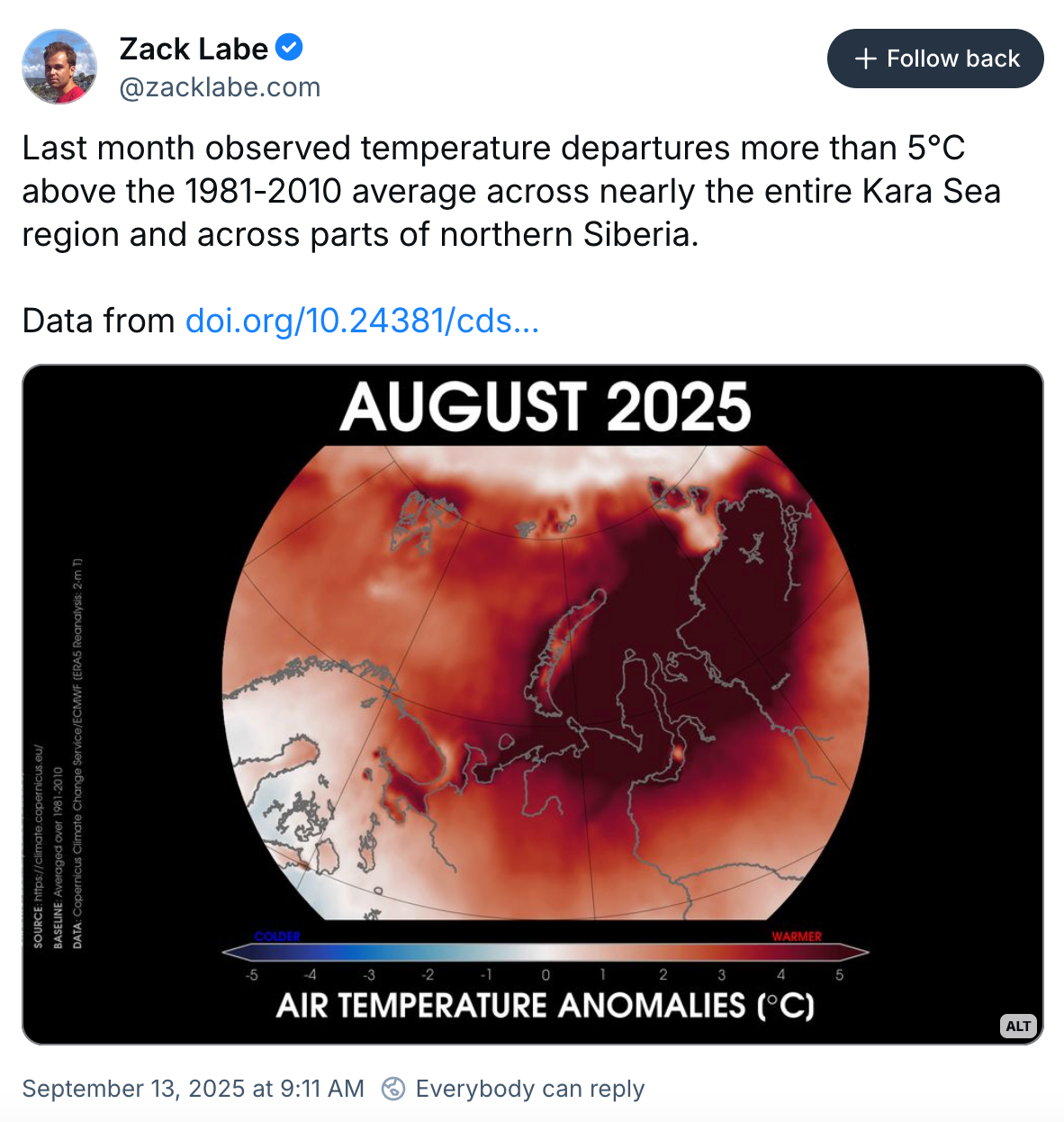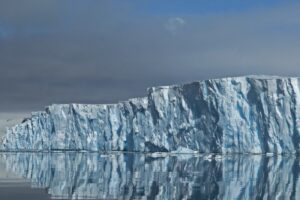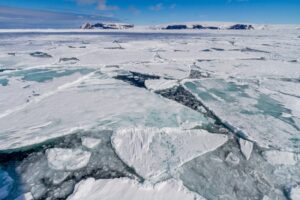Appropriations in action: CCLers rally to defend key climate and clean energy programs
By Elissa Tennant
Last month, CCLers mobilized en masse to contact their members of Congress ahead of the appropriations process. Together, we sent 12,859 emails to lawmakers encouraging them to fund key climate and clean energy programs.
Every year, Congress decides which programs and agencies to fund, and what level to fund them at. This is referred to as the appropriations process.
CCL hasn’t weighed in on this process before, but we felt this is an important avenue to urge Congress to reassert their authority. This action helped preserve our pathway to success, which we’ve identified is through work with Congress. Additionally, the Trump administration’s fiscal year 2026 (FY26) budget is seeking dramatic cuts to climate and clean energy programs, and we felt our voices could make a valuable impact.
The process is ongoing, but early signs from Congress are promising. On September 4, the House passed an energy and water appropriations bill. There’s no good way to sugarcoat it: This bill definitely included some harmful cuts to climate and clean energy programs, but the cuts are much less significant than those outlined in the President’s version of the budget.
During the debate on the bill, Republican members of Congress, including the chairman of the Energy and Water Development and Related Agencies Subcommittee, Rep. Chuck Fleischmann (R-TN), pushed back on completely gutting those programs. Publicly, he stated these programs are bipartisan and have his support.
Springing into action
Congress passes appropriations bills each year to fund government operations, usually by the September 30 deadline (the start of the federal fiscal year).
We told Congress to support robust funding for programs at NOAA, NASA, and the Department of Energy that will help preserve critical science and research, strengthen clean energy infrastructure, and ensure that America’s grid can meet rising demand.
We asked our representatives to reject proposed cuts to these agencies:
National Aeronautics and Space Administration (NASA)
NASA’s Earth-orbiting satellites and new technologies have helped scientists collect many different types of information about our planet and its climate. But the White House requested to slash NASA’s science funding by 47%.
National Oceanic and Atmospheric Administration (NOAA)
NOAA plays a critical role in weather forecasting, extreme weather warnings, and climate science. The agency’s research is also the gold standard for tracking the levels of carbon dioxide in the atmosphere and oceans, publishing that data publicly for America and the international community, and modeling/forecasting changes as a result. Yet the Trump administration’s proposed 2026 budget sought $2.2 billion cuts in NOAA research endeavors, grant programs and other initiatives, including dissolving the Office of Oceanic and Atmospheric Research.
Department of Energy (DOE)
The Department of Energy’s Office of Energy Efficiency and Renewable Energy (EERE) and Advanced Research Projects Agency (ARPA-E) are essential for energy innovation and reliability. EERE funds early-stage research and development activities to develop efficient energy and different types of energy sources, which is critical for America’s global energy leadership. Yet the White House had proposed cutting this office’s budget by 74%.
ARPA-E develops cutting edge energy technologies that keep us ahead of global competitors while driving down costs. It’s extremely bipartisan and well-supported in Congress; yet the White House’s budget proposes a 57% cut to this agency.
We lobbied on this, too!
If this all sounds familiar to you, it’s because we lobbied on this issue in July, too! During our 402 meetings on Capitol Hill, we asked Congress to support the clean energy transition for affordable and reliable power as well as a safer climate.
As a tactic to achieve this ask, we requested Congress support targeted programs that enable clean energy to compete, scale, and deliver dependable and affordable power to Americans. Specifically, we mentioned the DOE programs EERE and ARPA-A as two key programs to lower energy costs through innovation and clean energy investment.
Our mobilization built on this ask by generating 12,859 messages to Congress between August 13 and September 6.
The results so far
The appropriations process is a long one, but it’s a key focus for Congress right now. Appropriations are mostly negotiated behind the scenes, but we’re starting to see some results. The House passed its energy and water appropriations bill early in September, which significantly reduced cuts to Department of Energy programs we lobbied and mobilized around protecting. During the debate, Republican members of the committee, including the committee chair, Rep. Chuck Fleischmann (R-TN) pushed back on additional major cuts to the DOE programs.
While this specific bill will not necessarily be what’s ultimately signed into law (the Senate and House still have to negotiate and agree), we’ve already made a difference. Thanks to everyone who sent one of our 12,859 contacts to Congress. Remember, it’s timely actions like these that create a major impact in our country’s climate policies.
Keep the momentum going! Get loud for the climate and encourage others to do the same. View our latest actions here.
The post Appropriations in action: CCLers rally to defend key climate and clean energy programs appeared first on Citizens' Climate Lobby.
Appropriations in action: CCLers rally to defend key climate and clean energy programs
Greenhouse Gases
China Briefing 2 October 2025: China’s new pledge; electricity demand slows; steel overcapacity
Welcome to Carbon Brief’s China Briefing.
China Briefing handpicks and explains the most important climate and energy stories from China over the past fortnight. Subscribe for free here.
Key developments
China’s first-ever pledge to cut emissions
NEW CLIMATE TARGETS: In a video address to the UN last week, China’s president Xi Jinping personally pledged to cut his nation’s economy-wide greenhouse gas emissions to 7-10% below peak levels by 2035, while “striving to do better”, reported state broadcaster CCTV. Sky News called it a “landmark moment”, saying that this marked the first time China “made a commitment to cut its greenhouse gas emissions”. The announced target, along with other commitments such as expanding wind and solar power capacity to more than six times 2020 levels, will be included in China’s 2035 “nationally determined contribution” (NDC) under the Paris Agreement, which has not yet been submitted, reported BBC News. Carbon Brief published a detailed analysis of the announcement and hosted a webinar with climate policy experts to discuss their assessments. More details of the webinar can be found below.
AMBITION CRITICISM: In an article for Just Security, Sue Biniaz, former US principal deputy special envoy for climate, wrote that “at and around the UN event, the chatter regarding the announcement was generally negative”, adding that the announced target was “even lower than expected”. EU climate chief Wopke Hoekstra described China’s new climate pledge as falling “well short of what we believe is both achievable and necessary”, reported Reuters. In response, China accused the EU of “being slow to act on its own climate targets”, according to another Reuters report. The outlet said that Hoekstra’s “criticism of China’s new climate pledges shows ‘double standards and selective blindness’, China’s foreign ministry said on Friday”.
-
Sign up to Carbon Brief’s free “China Briefing” email newsletter. All you need to know about the latest developments relating to China and climate change. Sent to your inbox every Thursday.
MEDIA REACTION: Media outlets including the Guardian and the Times raised questions about the ambition of the target. Similarly, Bloomberg said it was “seen as too modest to put the nation on a path to net-zero and galvanise global climate action”. An editorial in state-run newspaper China Daily, however, called the target a “milestone in the nation’s long-term road map toward green, low-carbon development”. Li Shuo, director of the China Climate Hub at the Asia Society Policy Institute, wrote in a comment for the New York Times that China’s targets “may seem tepid”, but “beneath them is a bold wager: that steady action, powered by industrial strength and vision shielded from political volatility, will ultimately do more to contribute to the global climate effort than lofty, fickle promises ever could”.
Electricity demand growth slowed
PRESSURE DROP: The rate of growth in China’s electricity demand slowed in August, with “cooler” weather helping to “take some pressure off the grid”, reported Bloomberg, citing official data. The outlet added that electricity consumption rose 5% in August, compared with 8.6% in July and 5.4% in June. Still, China’s electricity demand in both July and August exceeded 1,000 terawatt hours – the first time this happened globally, said Chinese finance media outlet Cailianpress. According to a report by the China Electricity Council, China’s “electrification rate” has already surpassed that of “major developed economies in Europe and the US”, wrote China Energy Net.
MARKET PRICE: Two coastal provinces, Guangdong and Shandong, have used China’s new market-based pricing system for renewables to “steer clean-energy investment to the areas that suit them best, reported Bloomberg. According to the outlet, Guangdong, which is “surrounded by relatively shallow waters”, offered “generous rates to offshore wind”. In Shandong, the pricing system was used to “correct course and reduce a glut of solar power that has built up over the years”, added the outlet.
Steel to face new controls
CAPACITY CURBS: China has released a work plan for 2025-26 to “ban new steel capacity and reduce production, in the latest move to help balance supply and demand”, reported Bloomberg. The plan came after Beijing promised to cut steel output at the Two Sessions in March, according to the outlet. It also called for “significantly enhancing green, low-carbon and digital development levels” of the country’s steel sector, according to the industry news outlet BJX News. Financial media outlet Caixin said “more than 80% of China’s crude steel production capacity has completed ultra-low-emission retrofits, according to the China Iron and Steel Association”.
ETS EXPANSION: Meanwhile, the Ministry of Ecology and Environment issued draft allowance plans for the steel, cement and aluminium sectors for 2024 and 2025 in its national emissions trading scheme (ETS), reported Cailian Press. (The ETS was expanded to these sectors from 2024 in a draft policy, published late last year and covered by Carbon Brief. The expansion, which means that the ETS covers 60% of China’s emissions, rather than 40% previously, was confirmed in March.) Meanwhile, a report published by the State Council said that a total of 189m tonnes of carbon dioxide was traded on the ETS in 2024, according to Xinhua.
Typhoon Ragasa
DAMAGES IN ASIA: Nearly two million people in southern China had to be “relocated” after Typhoon Ragasa made landfall in Guangdong province last Wednesday, reported state news agency Xinhua. BBC News described the typhoon as the “world’s strongest storm this year” and said “a month’s worth of rain” was expected in the city of Zhuhai in one day. In the wider Asia-Pacific region, dozens of people were killed, while flights as well as businesses were also strongly affected, said the Financial Times.
CLIMATE CHANGE: Ragasa was intensified by “unusually hot oceans”, which can be linked to climate change, according to “preliminary studies” covered by the Hong Kong Free Press. “Rapid attribution” analysis by the French research group ClimaMeter concluded that cyclones such as Ragasa are around 10% wetter than they would have been in the past, added the outlet. Benjamin Horton, dean of the school of energy and environment at City University of Hong Kong, also linked Ragasa to climate change, saying extreme weather events “should not be happening at such regularity, so late in the season, of such intensity, of such high winds and of such big storm surges”, according to the SCMP.
40%
The share of China’s total solar capacity in 2024 made up by distributed photovoltaics – typically installed on rooftops – according to a report from the International Energy Agency, which said the share was up from 30% four years earlier. The report added that the “stock of electric cars grew by more than 650% over the same period”.
Spotlight
Experts: What China’s new climate pledge means for the world
Last week, president Xi Jinping announced several new pledges that will be included in China’s upcoming 2035 nationally determined contribution (NDC).
Carbon Brief held a webinar with several experts on what the new announcement means for China’s climate trajectory and the global energy transition. Below are the highlights of their answers. A recording of the webinar is available on the Carbon Brief website.
Ryna Cui, associate director and associate research professor at the University of Maryland Center for Global Sustainability
Our assessment of a plausible high ambition pathway for China [showed it] delivering a 27-31% reduction in total greenhouse gas emissions by 2035…In addition, we also model[led] a current policy pathway for China, which…also achieve[d] a 10-14% reduction…Both scenarios suggest a larger reduction compared to the 7-10% overall emission reduction target.
…
Under our current policy scenario for 2035, wind and solar total installed capacity is over 4,000 gigawatt (GW). It is over 4,700 gigawatt under a high ambition [scenario]. [The target announced by Xi is for 3,600GW by 2035.]
…
The non-fossil share of total primary energy…is 40% [under current policies] and 48% [under high ambition], compared to the 30% target announced [by Xi].
Lauri Myllyvirta, lead analyst and co-founder at the Centre for Research on Energy and Clean Air
At [China’s] rate of clean-energy growth, there is no more space for…coal, in general, to grow. So if you were to announce targets of 20-30% reduction in carbon dioxide, then you have to recognise that there’s going to be a major downsizing of the coal industry.
That seems to be a decision that China’s leadership is still postponing. Are you going to put reins on this clean-energy boom, or are you going to accept that the coal industry has to start downsizing in a big way?
…
These targets really, to me, show that the leadership was not prepared to resolve that conflict and say that coal is the one that has to give.
Anika Patel, China analyst at Carbon Brief
[In terms of what’s next,] one of the big signals…is COP30. What else will be announced that could signal China’s relative level of climate ambition?
Will there be quantitative targets placed on things like climate finance?…Will there be more announcements around south-south cooperation? What will China’s signaling on fossil fuels – especially coal – in the final COP30 outcome be?
…
At the same time, we’ve got the 15th five-year plan coming up…We’re expecting a new set of overarching targets for 2026-2030, and traditionally there have always been a couple of climate targets [among the plan’s headline targets]. From that, we can expect to start seeing signals about what the level of climate ambition for the next five years will be.
Li Shuo, director of the China Climate Hub at the Asia Society Policy Institute
There has been a very strong alignment now in the Chinese system between its decarbonisation goals and its economic development agenda…I think that strong alignment is what will propel the country to cut more carbon over time.
I also think that when you begin to realise [that]…you will then begin to realise it is not necessarily just the [state-level] EU-China climate relationship…[or] COPs that we should pay attention to. New actors are emerging.
We need to pay attention to BYD [and] CATL. We need to pay attention to [low-carbon commercial and investment activity in] Brazil…[and] Indonesia. Those factors and actors, over the next ten years or so, will begin to drive carbon-emission reduction in a more significant and meaningful way than countries’ NDCs.
Watch, read, listen
‘NEW ENERGY’: A comment on the “high-quality development” of China’s “new energy” sector was published by the Communist party’s Study Times – an official newspaper edited by the central school of the Chinese Communist party – under the byline of Wang Hongzhi, head of the National Energy Administration.
HIGH-LEVEL COMMENT: The Communist party-affiliated newspaper People’s Daily published an article under the byline Zhong Caiwen, used to indicate party leaders’ views on economic affairs, saying “green development is the defining feature of China’s high-quality economic growth”.
EXTREME WEATHER: Chinese media outlet 21st Century Business Herald conducted an interview with Xu Xiaofeng, former deputy director of the China Meteorological Administration and president of the China Meteorological Service Association, who talked about the “high intensity of extreme weather events” under climate change.
CARBON MARKETS: Ma Aimin, former deputy director of the National Centre for Climate Change Strategy and International Cooperation, told Jiemian that China’s carbon market (ETS) needed to enhance its “trading activity” and that the next two years will be a “critical period” for voluntary carbon trading (CCERs).
New science
Development policy affects coastal flood exposure in China more than sea-level rise
Nature Climate Change
Exposure to coastal flooding in China over the 21st century will depend more on “policy decisions” than the rate of sea-level rise, according to new research. The authors combined simulations of population and land use changes with flood models that incorporate factors such as sea level rise and storm surges. They said their paper offers a “more nuanced understanding of coastal risks” than other existing assessments.
Spatiotemporal patterns and drivers of wildfire CO2 emissions in China from 2001 to 2022
Atmospheric Chemistry and Physics
Annual CO2 emissions from forest and shrub fires in China decreased over 2001-22, but increased for cropland fires, a new study found. The analysis noted that the upward trend in cropland fire emissions is primarily in the country’s north-east and is “closely linked to region-specific straw-burning policies”. The researchers found that emissions from grassland fires remained relatively stable over the two decades assessed.
China Briefing is compiled by Wanyuan Song and Anika Patel. It is edited by Wanyuan Song and Dr Simon Evans. Please send tips and feedback to china@carbonbrief.org
The post China Briefing 2 October 2025: China’s new pledge; electricity demand slows; steel overcapacity appeared first on Carbon Brief.
China Briefing 2 October 2025: China’s new pledge; electricity demand slows; steel overcapacity
Greenhouse Gases
The clean energy economy is here
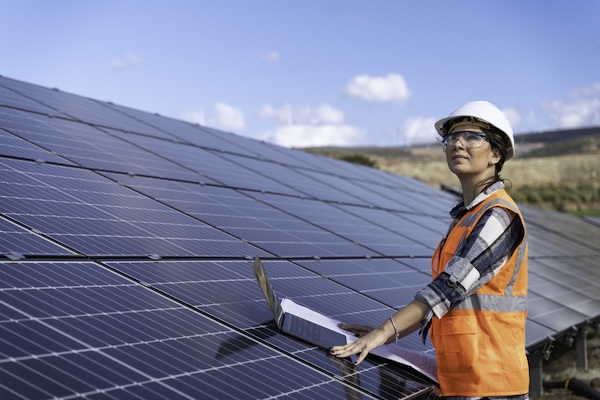
The clean energy economy is here
by Elissa Tennant
The clean energy economy is here, baby, and we’re rolling out the welcome mat. Despite a series of rollbacks under the current administration, this tidal wave can’t be stopped. We’re still seeing a transition to cleaner energy sources in real time that will help us address climate change while remaining competitive with other global superpowers.
This shift toward cleaner energy comes right on time. Americans are facing extreme weather events, like heatwaves and wildfires, exacerbated by a changing climate. We’re also facing a home insurance crisis and rapidly rising electricity bills. Transitioning our energy sources is not only crucial for addressing climate change, it’s a massive economic opportunity.
What is the clean energy economy?
A clean energy economy makes use of renewable energy sources to reduce emissions and boost economic growth. Countries that make a significant investment in clean energy infrastructure are better poised to compete in a global market. Domestically, these countries may also see an increase in job opportunities and cheaper power sources for citizens.
There are many sources of clean energy that make up our energy mix, each of which has its pros and cons. Examples include:
- Solar power: Converts energy from the sun into electricity.
- Wind energy: Converts kinetic energy from blowing winds into electricity.
- Nuclear power: Converts energy from nuclear reactions into electricity.
- Geothermal energy: Converts energy from the Earth’s natural heat into power sources.
- Hydropower energy: Converts kinetic energy from naturally moving water sources into electricity.
- Battery storage: Investment in devices that allow for power generated by the above sources to be stored and used later.
Clean energy setbacks
The United States’ biggest investment in clean energy came in the form of the Inflation Reduction Act of 2022 (IRA). Over its tenure, the IRA spurred hundreds of billions of dollars in clean energy investments and a rapid deployment of projects like solar farms and battery storage facilities.

U.S. clean power generation capacity additions, showing big growth in solar and battery projects since the IRA was passed. Source: American Clean Power
According to an analysis from CCL’s Research Manager, Dana Nuccitelli, investments from the IRA will save about 1 billion tons of carbon dioxide pollution over the next decade. That’s equivalent to permanently shutting down 26 coal power plants, or taking 23 million cars off the road.
Though the One Big Beautiful Bill Act, signed into law July 4, 2025, has ended many clean energy incentives early, it didn’t completely end investments. The administration still supports funding for certain technologies with bipartisan interest, like geothermal and nuclear. The clean energy economy is here, and it doesn’t appear to be making a grand exit any time soon.
How clean energy boosts the U.S. economy
There are several ways in which clean energy investments support a healthy economy:
Job creation
In 2024, a Department of Energy report found that clean energy jobs grew at more than twice the rate of overall employment. In many areas, clean energy jobs have outpaced fossil fuel-related jobs, especially under the IRA. Currently, the five states with the most energy efficient jobs are:
- California (302,176)
- Texas (172,917)
- New York (129,946)
- Florida (125,234)
- Illinois (86,728)
Notably, clean energy requires equipment, including solar panels, wind turbines, batteries, and EV components. The opportunity to fuel the clean energy economy by making these parts in the U.S. provides new manufacturing jobs.
Community development
Clean energy projects are revitalizing communities across the country. The IRA included a landmark Greenhouse Gas Reduction Fund, administered by the EPA, that provided billions in grants for clean energy investments with an emphasis on revitalizing communities “that have historically been left behind.” This funding has since been revoked, but agencies like the Department of Energy and United States Department of Agriculture continue to work with local communities, and especially urban farmers, to spur clean energy investments like solar panels in otherwise unused stretches of land.
Lower energy costs
Without home and building efficiency, air conditioning runs overtime and causes electricity bills to skyrocket. Inflation and regional utility price hikes also contribute to this issue. Switching to cleaner sources of energy provides long-term affordability, giving consumers money back in their pockets.
Energy security & independence
When we continue to invest in oil, we continue to rely on volatile foreign oil markets, subject to shortages, price hikes, and any number of political issues. By investing in clean energy sources domestically, we increase our energy independence. We also promote energy security, reducing the prevalence of power outages and even widespread crises like the Great Texas Freeze.
Climate and public health benefits
The clean energy economy doesn’t just support America’s national wallet. It makes major dents in harmful carbon emissions that fuel climate change.
Switching to clean energy reduces pollution in the air we breathe. It also lowers the risk of harm from heat waves and provides more resilient infrastructure to withstand extreme weather events.
For example: Fossil fuels tend to intensify the urban heat island effect, which states that cities tend to be slightly warmer than surrounding areas. As cities crank their A/C, energy bills rise and residents are subject to peak price hikes and grid failures as fossil fuel-based systems scramble to keep up.
Renewable energy helps decrease the need for polluting peak energy sources during heat waves. Solar panels and energy storage also improve local grid reliability during climate extremes. If we don’t invest in these technologies, we’re stuck with outdated energy sources that ultimately raise global temperatures, making the problem even worse.
What does this mean for everyday Americans?
By investing in clean energy, everyday Americans will see lower utility bills, more local job opportunities, and cleaner air and water. We’ll have more options to live sustainability, from electric vehicles to smart thermostats and clean power providers.
We may have experienced a setback with cuts to the Inflation Reduction Act this year, but the fight isn’t over. We need to continue to support clean energy incentives and tax credits that encourage private investment and innovation.
The clean energy economy isn’t a future vision — it’s happening now, and we can all benefit from embracing it.
How to take action on climate change now
Supporting the clean energy economy means individuals, businesses, and policymakers must collectively come together to form long-term solutions. These long-lasting policies are what will protect the health of our climate for generations to come. Help us get there by taking action today:
 Volunteer for the environment locally
Volunteer for the environment locally
 Electrify your home with clean energy
Electrify your home with clean energy
 Write or Call Congress and let them know you support a national transition to cleaner energy sources
Write or Call Congress and let them know you support a national transition to cleaner energy sources
 Attend one of our climate change conferences this year
Attend one of our climate change conferences this year
 Join one of our weekly Informational Webinars and learn what Citizens’ Climate Lobby is all about
Join one of our weekly Informational Webinars and learn what Citizens’ Climate Lobby is all about
Interested in getting involved? At Citizens’ Climate Lobby, we welcome any and all everyday citizens to join us and thousands of volunteers around the world in our collective goal of climate action.
The post The clean energy economy is here appeared first on Citizens' Climate Lobby.
Greenhouse Gases
Antarctic sea ice winter peak in 2025 is third smallest on record
Antarctic sea ice has recorded its third-smallest winter peak extent since satellite records began 47 years ago, new data reveals.
Provisional data from the US National Snow and Ice Data Center (NSIDC) shows that Antarctic sea ice reached a winter maximum of 17.81m square kilometres (km2) on 17 September.
This is 900,000km2 below the 1981-2010 average maximum extent – the historical baseline against which more recent sea ice extent is typically compared.
According to one expert, the “lengthening trend of lower Antarctic sea ice poses real concerns regarding stability and melting of the ice sheet”.
Meanwhile, at the Earth’s other pole, Arctic sea ice reached its annual minimum on 10 September, ranking as the joint-10th lowest in the satellite record.
At 1.6m km2, the 2025 minimum shares the spot with 2008 and 2010. The NSIDC notes that all 19 of the lowest sea ice extents in the record have occurred in the past 19 years.
Antarctic peak
For decades, scientists have been using satellite data to track the annual cycle of sea ice growth and melt at the world’s poles. This is a key way to monitor the “health” of sea ice in both the Arctic and Antarctic.
The map below shows Antarctic sea ice on the day of its maximum extent for the year on 17 September 2025, where the yellow line shows the 1981-2010 average.
The NSIDC says that sea ice extent was “markedly below average” in the Indian Ocean and the Bellingshausen Sea, but “slightly above average” over the Ross Sea.

In an NSIDC press release announcing the Antarctic maximum, Dr Ted Scambos, a senior research scientist at the Cooperative Institute for Research In Environmental Sciences, said:
“The lengthening trend of lower Antarctic sea ice poses real concerns regarding stability and melting of the ice sheet. However, it may also be leading to greater snowfall over the continent, which would slow the progression of sea level rise.”
Antarctic sea ice growth
In its typical annual cycle, Antarctic sea ice grows during winter towards its annual maximum extent in September or October. It then melts throughout the spring and summer towards its March minimum.
Earlier this year, Antarctic sea ice recorded its second-smallest summer minimum on record.
At 1.98m m2, this was the fourth consecutive year that Antarctic sea ice had fallen below 2m km2, the NSIDC noted.
In its monthly sea ice updates, the NSIDC reported that sea ice then grew at a “near-average pace”. During this period, sea ice “expanded rapidly” in the last areas to lose ice, including the Ross Sea and eastern Weddell Sea, it said.

The NSIDC explained that sea ice rebounded quickly in the Ross Sea area because ice extent had retreated “slowly” there the month before – meaning that the upper ocean layer did not have time to accumulate heat which would slow the winter freeze.
In April, “the situation in the Antarctic remained fickle”, the NSIDC said. At the beginning of the month, sea ice extent neared “record-low” daily extents, but as the month progressed ice cover expanded “fairly quickly”, it said.
May had “below average growth” in Antarctic sea ice and saw the fifth lowest record for Antarctic sea extent.
As June began, the the Bellingshausen Sea and eastern Queen Maud Lord regions were “far behind” in ice re-growth, it said, adding that the Bellingshausen Sea was almost entirely ice-free as temperatures were 6-8C above average.
In June, Antarctic sea ice was 1.28m km2 below the 1981-2010 baseline, with “particularly low” sea ice extent in the Bellingshausen Sea and the Indian Ocean sector, according to the NSIDC. This was the third-lowest sea ice extent ever recorded for the month of June, it said.
Throughout July, Antarctic sea ice extent grew at a “slower-than-average” rate, according to the NSIDC. By the end of the month, Antarctic sea ice extent was 1.3m km2 below the baseline, it noted.
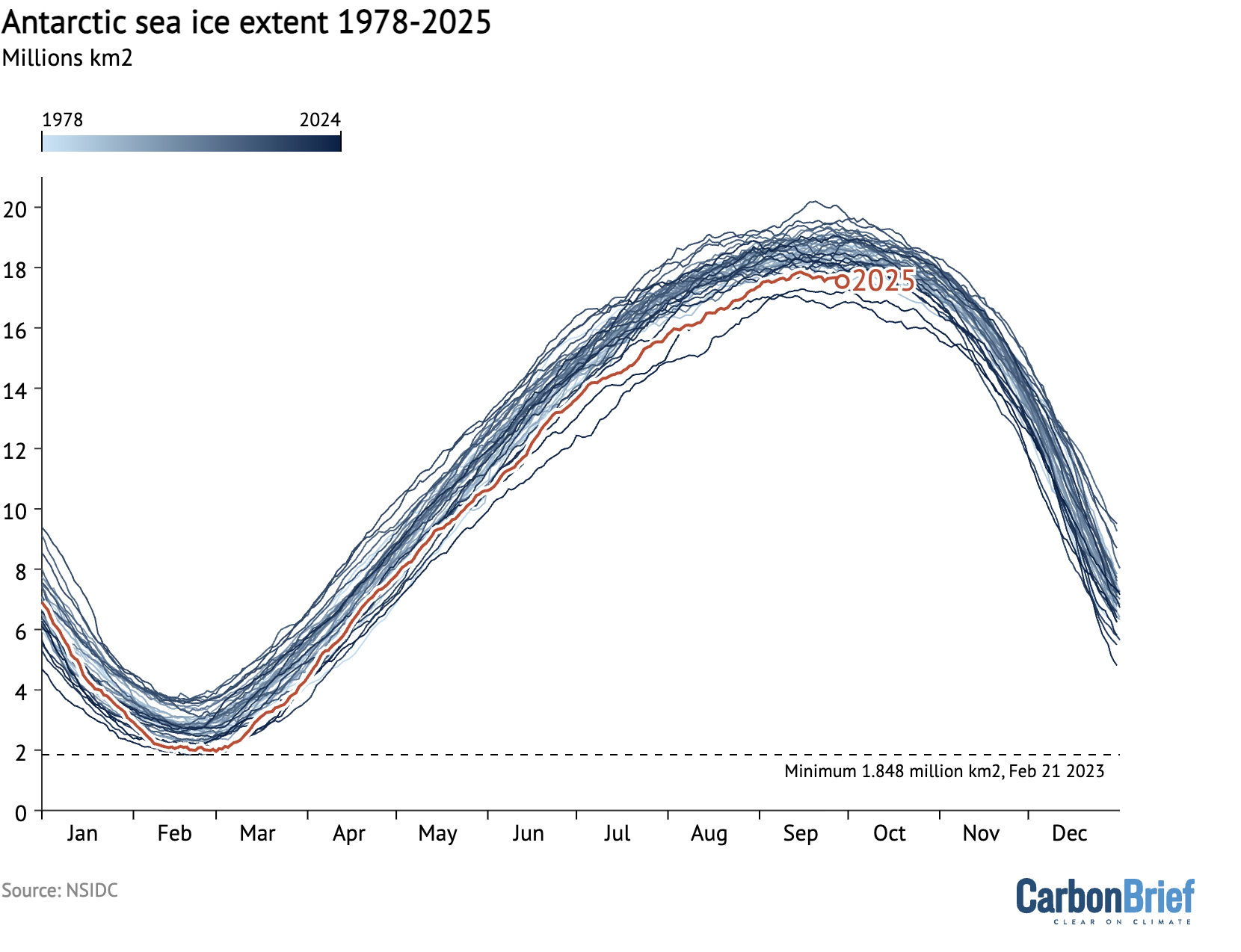
Arctic melt season
In the Arctic, sea ice cover typically reaches its high point in March, before dropping to its September minimum at the end of the northern-hemisphere summer.
The 2025 Arctic sea ice winter peak was the smallest since satellite records began. The peak, recorded on 22 March, was 1.31m km2 below the average maximum for the 1981-2010 historical baseline.
In March, Arctic sea ice extent averaged 14.14m km2 – the lowest in the satellite record, according to the NSIDC. It noted that, at the time, average air temperature was above the historical baseline across much of the Arctic region.

Arctic sea ice extent then “changed very little” throughout April, remaining “nearly constant” until the final days of the month, the NSIDC reported.
It added that the final days of April saw Arctic sea ice extent drop due to ice retreat along the coast of the Barents Sea.
According to data, the main reason why the April total extent remained largely flat was due to an increase of sea ice in the northeastern Barents Seas that “offset” losses elsewhere.
Below-average air temperatures over the northern Norwegian and Barents Seas was the most “notable feature” of April 2025, the NSIDC said.
May was marked by a decline in Arctic sea ice extent at a faster-than-average pace, the NSIDC noted, resulting in the seventh-lowest May extent on record.
It added that ice loss in May was “primarily” in the Barents Sea, Bering Sea and the Sea of Okhotsk.
In June, Arctic sea ice extent averaged 10.48m km2 – the second-lowest average on record for the month, the NSIDC said. It noted that sea ice hit record-low levels over 20 June and 26 June and tracked at “near-record” low levels through the month. The Barents and Kara Seas were both “nearly ice-free” by the end June.
Hudson Bay ice extent was also “considerably below average” throughout June and northern parts of Baffin Bay were nearly ice-free, it said.
By the end of July, daily sea ice extent in the Arctic had fallen to 7.66m km2 – the third lowest in the satellite record, the NSIDC reported. It noted that, for most of the month, Arctic sea ice extent tracked close to levels recorded for 2012 – the year in which Arctic sea ice extent reached its lowest-ever September minimum.
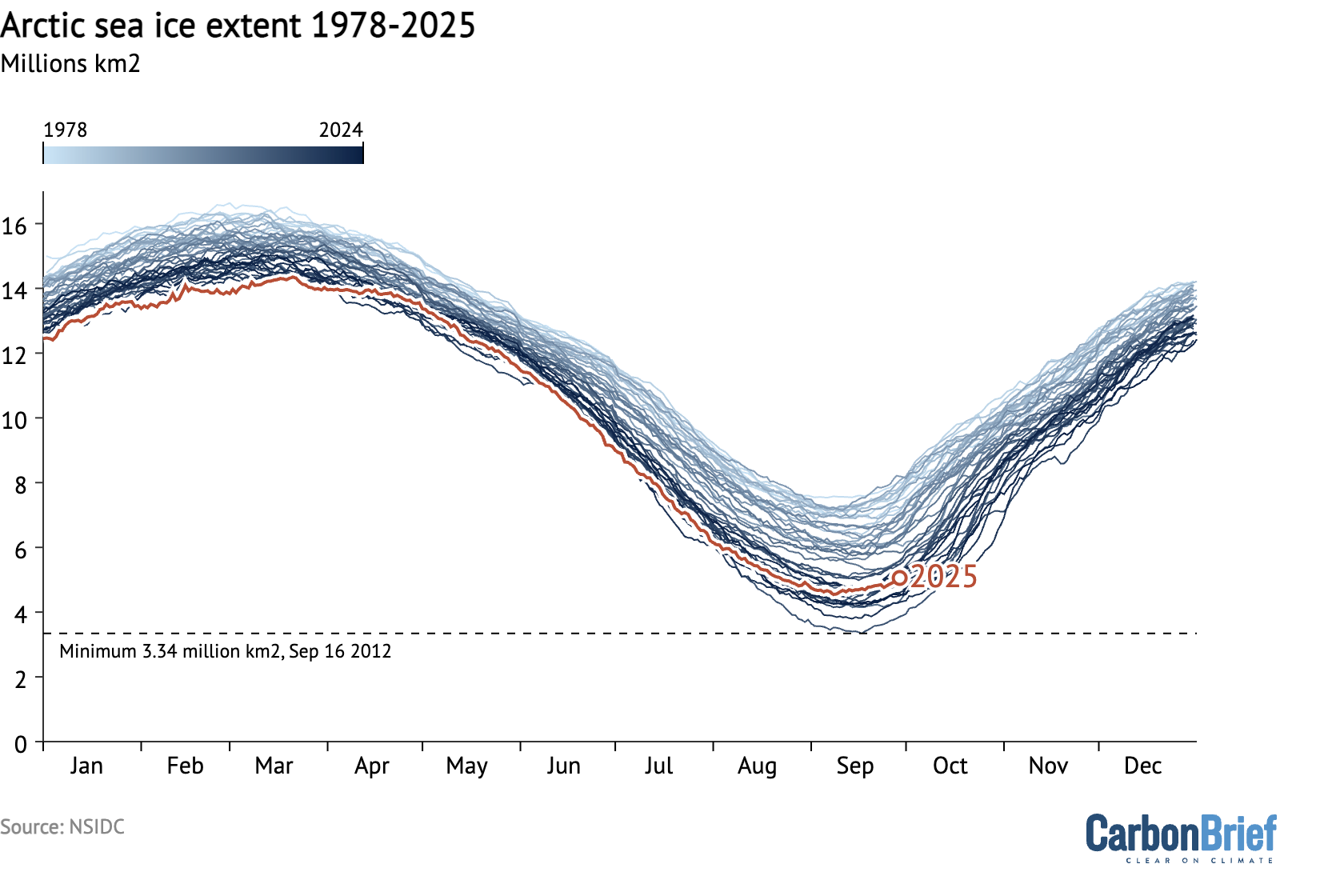
Throughout August, the NSIDC reported that sea ice “rapidly melted and compacted” north of Alaska in the Beaufort Sea, with sea ice extent averaging at 5.41m km2 – the seventh lowest on record.
Dr Zack Labe – a climate scientist at Climate Central – tells Carbon Brief that northern Siberia saw August air temperatures more than 5C above the 1981-2010 average, resulting in “a striking amount of open water along the Atlantic side of the Arctic that would normally be ice-covered”.
At an annual minimum of 1.6m km2, this year’s Arctic minimum is “pretty unremarkable”, Labe tells Carbon Brief, and “adds to the evidence of a clear slowdown in the rate of summer Arctic sea ice loss”.
However, Labe stresses that this is “not surprising” – referencing a recent study which “clearly shows how internal variability can temporarily drive periods of slower melt in a warming climate, as well as periods of rapid melt, such as in the early 2000s”. (For more on this research, read Carbon Brief’s guest post).
He adds:
“It is only a matter of time before summertime melt accelerates again. This is not a good news story, especially since in many other months we still see a clear downward trend…
“While the past decade of summers may give the appearance of a slowdown, regional extremes such as in the Kara Sea this year underscore that the Arctic is already radically different from past decades. The driver is clear – human-caused climate change.”
Satellite switch
For decades, NSIDC has tracked sea ice using data from weather satellites run by the US Navy. However, earlier this year, Mongabay reported that NSIDC scientists “noticed holes in the data they were receiving”.
The article explains:
“When scientists inquired with the Department of Defense (DoD), they were told not all data were being downloaded and access to the data had been deprioritised. Soon after, the DoD said it would stop sharing…data altogether, citing military cybersecurity risks in the old systems.”
NSIDC scientist Walt Meier told Science that while the US satellites “are up there and functioning…we’re not getting all the data anymore, at least regularly”.
The DoD then set a cut-off date to “cease distribution data from the Defense Meteorological Satellite Programme” on 31 July.
In June, the NSIDC announced that it would “explore switching to a different sensor” aboard a Japanese satellite that was launched in 2012.
The only other option available to NSIDC was a “series of Chinese weather satellites, which the country is already using to produce its own record of sea ice”, Science noted. It added that a new US DoD weather satellite, launched last year, is “also capable of collecting similar data, but its data have not yet been made public”.
The switch was completed by the July cut-off date and NSIDC reprocessed all data for 2025 to use the new data source to ensure “consistency through the year”.
The post Antarctic sea ice winter peak in 2025 is third smallest on record appeared first on Carbon Brief.
Antarctic sea ice winter peak in 2025 is third smallest on record
-
Climate Change2 years ago
Spanish-language misinformation on renewable energy spreads online, report shows
-
Climate Change Videos2 years ago
The toxic gas flares fuelling Nigeria’s climate change – BBC News
-
Climate Change2 months ago
Guest post: Why China is still building new coal – and when it might stop
-

 Greenhouse Gases1 year ago
Greenhouse Gases1 year ago嘉宾来稿:满足中国增长的用电需求 光伏加储能“比新建煤电更实惠”
-

 Climate Change1 year ago
Climate Change1 year ago嘉宾来稿:满足中国增长的用电需求 光伏加储能“比新建煤电更实惠”
-

 Carbon Footprint1 year ago
Carbon Footprint1 year agoUS SEC’s Climate Disclosure Rules Spur Renewed Interest in Carbon Credits
-
Greenhouse Gases2 months ago
Guest post: Why China is still building new coal – and when it might stop
-
Renewable Energy3 months ago
US Grid Strain, Possible Allete Sale


